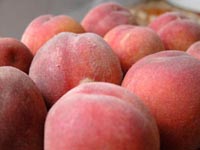Rediscovering the kitchen garden
Kathryn Bradley-Hole finds comfort in her convalescence from re-runs of an inspiring programme on the kitchen garden which was much before its time…


I threw another log on the fire and settled down with steaming Lemsip, the television wittering comfortingly in the background. Fortunately, my moment of convalescence coincided with a welcome tonic: long overdue re-runs of Victorian Kitchen Garden, a baker's dozen of programmes that opened the nation's eyes to how food was grown in the days of Empire.
Presented by a pair of elderly sons of toil?Harry Dodson, whose gardening career began in the 1930s, and Peter Thoday, a horticultural lecturer?it demonstrated in commendable detail the hard-learned skills of Victorian country-house gardeners whose jealously guarded horticultural conjuring tricks brought exotic fruits and flowers to landowners' tables in every week of the year.
'It is parssible to get three crops of melons out of one 'ouse in the course of a yearrr,' advised Mr Dodson in an engaging Old Hampshire drawl as rare today as a glass cucumber straightener, while he dug up turf sods and ranged them upside-down on iron grids in the melon house to insulate pots of seedlings.
He pollinated the indoor peaches with a rabbit's tail, but outdoors, the nectarines, tied in fans to the garden wall, were frost-protected by Harry, not with high-tech fleece, but branches of yew and laurel cut from the shrubberies. He built insulation wraps for cardoons out of straw, nurtured seakale and chicory in the dark of the boiler room, planted out historic Edzell Blue potatoes, Painted Lady runner beans and Ne Plus Ultra peas, and forced early strawberries in the hotbeds of steaming manure.
Plodding along, as unhurried as a donkey-led mowing machine in a 100-acre meadow, Victorian Kitchen Garden could never be made so lyrically today. Yet this wonderful series, now consigned to the outer reaches of satellite broadcast channels, was groundbreaking in more than the literal sense.
Combining organic husbandry, seed conservation, recycling, composting, local trading and a total absence of plastics, it could hardly be more up to the minute, both ecologically and politically, despite its Upstairs, Downstairs inspiration. But I noticed from the credits that it was first broadcast in 1987, having been filmed throughout the year before that. So, Happy 20th Anniversary, Victorian Kitchen Garden, and a Happy Coming of Age, too. You deserve a fresh airing and, who knows, perhaps a new gene-ration will love you as much as we did first time round.
The other event that hastened my recuperation was the arrival of Woottens Handbook, 2007. For some years, Suffolk nurseryman Michael Loftus has produced a handsome catalogue of his tender and hardy herbaceous plants, always an excellent read and laced with exquisite botanical illustrations. This year, he has jettisoned the lovely paintings, but instead produced a door-stopping book of nearly 300 pages, illustrated with hundreds of ravishing photographs of his stock (01502 478258; www.woottensplants.co.uk). The irises, hemerocallis, geraniums, pelargoniums and auriculas in which Mr Loftus specialises are well illustrated, although he grows many other species, too, all usefully arranged into sections for sunny locations and for shade.
Exquisite houses, the beauty of Nature, and how to get the most from your life, straight to your inbox.
I can recommend Mr Loftus's pelargoniums, which we have had for many years and add to every spring, but I was also delighted to read in his new handbook this cautionary extract from Beverley Nichols' Laughter on the Stairs: 'Pelargoniums are for me a sort of test flower, for my experience has told me that people who do not like Pelargoniums have something morally unsound about them. Sooner or later you will find them out; you will discover that they drink or steal or speak sharply to their cat. Never trust a man or woman who is not passionately devoted to Pelargoniums.' Hear, hear.
In its scope and ambition, Woottens Handbook is reminiscent of the Manual of Horticulture produced annually by Kelways nursery of Somerset, during the belle époque. Where for Kelways, peonies were the glamorous main event (although it bred many famous irises, too), at Woottens, modern iris cultivars steal the show. Bearded irises 'need an open position where they can feel the breeze,' advises Mr Loftus. 'Plant them in large masses and experience the ultimate in nasal ecstasy.' The thought alone is enough to clear the stuffiest head.
Country Life is unlike any other magazine: the only glossy weekly on the newsstand and the only magazine that has been guest-edited by His Majesty The King not once, but twice. It is a celebration of modern rural life and all its diverse joys and pleasures — that was first published in Queen Victoria's Diamond Jubilee year. Our eclectic mixture of witty and informative content — from the most up-to-date property news and commentary and a coveted glimpse inside some of the UK's best houses and gardens, to gardening, the arts and interior design, written by experts in their field — still cannot be found in print or online, anywhere else.
